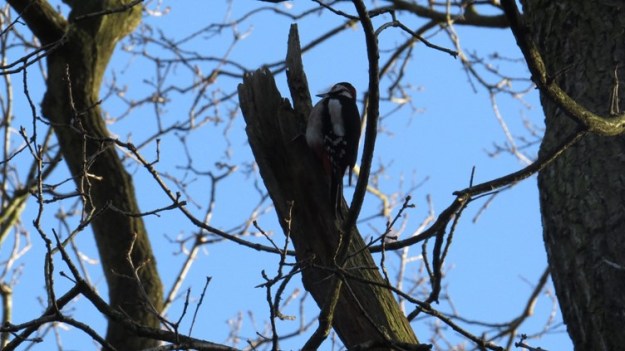Dear readers, there is something about the stark black and white patterning of the Great Spotted Woodpecker, combined with the red patch of the vent, that reminds me of the paintings of Mondrian.

This bird is a female – the males have a small patch of red on the back of their heads, and the juveniles have a complete red cap.
![Male Great Spotted Woodpecker (By Ken Billington (Own work) [CC BY-SA 3.0 (http://creativecommons.org/licenses/by-sa/3.0)], via Wikimedia Commons)](https://i0.wp.com/bugwomanlondon.com/wp-content/uploads/2015/01/great_spotted_woodpecker_dendrocopos_major_2.jpg?resize=625%2C352&ssl=1)
Male Great Spotted Woodpecker (By Ken Billington (Own work) [CC BY-SA 3.0 (http://creativecommons.org/licenses/by-sa/3.0)], via Wikimedia Commons)
![Juvenile Great spotted Woodpecker (By Jason Thompson (Flickr: Great Spotted woodpecker (juvenile)) [CC BY 2.0 (http://creativecommons.org/licenses/by/2.0)], via Wikimedia Commons)](https://i0.wp.com/bugwomanlondon.com/wp-content/uploads/2015/01/great_spotted_woodpecker_juvenile.jpg?resize=625%2C500&ssl=1)
Juvenile Great spotted Woodpecker (By Jason Thompson (Flickr: Great Spotted woodpecker (juvenile)) [CC BY 2.0 (http://creativecommons.org/licenses/by/2.0)], via Wikimedia Commons)

I tend to see the woodpecker in the garden during the winter. In spring and summer, they spend much more time in Coldfall Wood. Last week, as I walked through the hornbeams, I heard an extraordinary sound, midway between a creak and a drumroll. I followed the noise, eager to see if it was what I thought it was. After some time standing at the bottom of a tree, almost falling backwards as I leaned further and further back, I saw this:
 A woodpecker was drumming away on a dead branch, the sound echoing through the trees. The bird’s head was just a blur as he knocked his beak repeatedly against the wood – he is able to make between five and twenty strikes per half second. This wasn’t an attempt to make a nest hole – he was declaring his territory. After every session of drumming he looked around, as if listening, and sure enough, another bird was answering his challenge from the other side of the wood. Both male and female Great Spotted Woodpeckers drum, which makes me think that they share a territory during the breeding season, and that both sexes are involved in defending it.
A woodpecker was drumming away on a dead branch, the sound echoing through the trees. The bird’s head was just a blur as he knocked his beak repeatedly against the wood – he is able to make between five and twenty strikes per half second. This wasn’t an attempt to make a nest hole – he was declaring his territory. After every session of drumming he looked around, as if listening, and sure enough, another bird was answering his challenge from the other side of the wood. Both male and female Great Spotted Woodpeckers drum, which makes me think that they share a territory during the breeding season, and that both sexes are involved in defending it.

I wondered if the Woodpecker was choosing his branch with care, in order to make the maximum amount of noise. If so, he joins an elite company of animals who use the world around them to create displays. I am thinking particularly of a male chimpanzee that I knew in Cameroon, who would choose a hollow tree to kick when he was displaying over all others, presumably because of its deep, bass-drum quality.

And then there was a cackle and another Great Spotted Woodpecker appeared. The two birds flew up and clashed wings, like dragonflies, before heading out over the houses. A third bird also joined in, possibly the original bird’s mate, so for a few seconds the blue sky was patterned with black and white and red shapes. And then, all was silent again. But there was no doubt in my mind that spring had already begun, and the great battle to reproduce had started all over again. As broken as the world sometimes seems, the great engine of the seasons is still working.
To see a short video of one of the woodpeckers drumming, please see below. Quality isn’t great, but you can hear the bird (though you might want to take a seasickness pill before viewing 🙂 )


Great little clip, the swooshy camera work added to the sense of place! Will now be listening for that kind of sound when I’m out walking.
Bless you Julia – the bird was so high up, and the lens on my camera was so extended that it was all wobbling about in a very seasickness-inducing way. So pleased to have been able to capture it drumming away, though….
Interesting analogy between the bird’s name and the artist!
Pingback: The Bird That Runs Down Tree Trunks | Bug Woman – Adventures in London